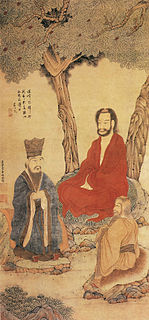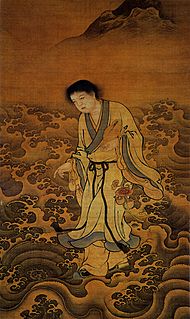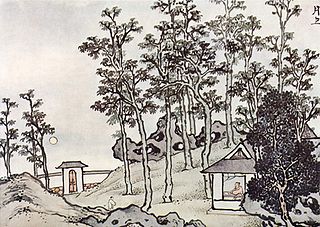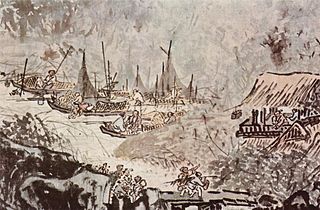 W
WAn Zhengwen ; was an imperial Chinese painter during the Ming Dynasty (1368–1644).
 W
WChén Chún was a Ming Dynasty artist. Born into a wealthy family of scholar-officials in Suzhou, he learned calligraphy from Wen Zhengming, one of the Four Masters of the Ming dynasty. Chén Chún later broke with Wen to favor a more freestyle method of ink wash painting. He was associated with the Wu School of literary painting. Mi Fu of the Song Dynasty had a strong influence on his work. Chén executed many landscapes, but to a degree is noted as a "Bird-and-flower" painter.
 W
WChen Jiru was a Chinese landscape painter, calligrapher and essayist during the Ming Dynasty (1368–1644).
 W
WDai Jin was a Chinese artist best known for being the founder of the Zhe School of Ming dynasty painting.
 W
WDing Yunpeng was a Chinese painter especially of human figures and landscapes during the Ming Dynasty (1368–1644).
 W
WDu Qiong ; ca. 1396-1474 was a Chinese landscape painter, calligrapher and poet during the Ming dynasty (1368–1644).
 W
WGuo Chun, was an imperial Chinese painter in the early Ming Dynasty.
 W
WLi Zai ; ca. (unknown-1431) was a Chinese painter of landscapes and human figures during the Ming Dynasty (1368–1644). His specific birth year is not known.
 W
WLiu Jun, courtesy name Ting Wei (廷偉), was a Chinese landscape and person painter in the early Ming Dynasty. His birth and death years are unknown.
 W
WLù Zhì, formerly romanized as Lu Chih, was a Chinese landscape painter, calligrapher, and poet during the Ming Dynasty (1368–1644).
 W
WMa Shi, courtesy name as Jingzhan (敬瞻), was a Chinese landscape painter and poet during the Xuande era of the early Ming Dynasty. His birth and death years are unknown. He was a native of Jiading.
 W
WShen Zhou, courtesy name Qi'nan (启南) and Shitian (石田), was a Chinese painter in the Ming dynasty.
 W
WSong Xu, was a Chinese landscape painter. His courtesy name was Chuyang (初炀) and pen name was Shimen. Song eventually became a Buddhist priest and adopted various religious names. He was, according to some sources from Jixing in Zhejiang province, but others assert that he was from Huzhou in Zhejiang Province.
 W
WSūn Kèhóng ; ca. 1533-1611 was a Chinese landscape painter, calligrapher, and poet during the Ming Dynasty (1368–1644).
 W
WSun Long (simplified Chinese: 孙隆; traditional Chinese: 孫隆; pinyin: Sūn Lóng; Wade–Giles: Sun Lung; was a Chinese landscape painter active during the early Ming Dynasty. His specific dates of birth and death are not known, though he was active during the Xuande era.
 W
WWang E was an imperial landscape painter during the Ming Dynasty.
 W
WWang Fu ; ca. 1362-1416 was a Chinese landscape painter, calligrapher, and poet during the Ming Dynasty (1368–1644).
 W
WWang Jian ; c. 1598–1677 was a Chinese landscape painter during the Ming dynasty (1368–1644) and Qing dynasty (1636–1912).
 W
WWang Meng was a Chinese painter during the Yuan Dynasty.
 W
WWáng Shímǐn was a Chinese landscape painter during the late Ming Dynasty and early Qing Dynasty (1644–1911).
 W
WWen Boren ; ca. (1502–1575) was a Chinese landscape painter during the Ming Dynasty (1368–1644).
 W
WWen Jia ; ca. 1501-1583 was a Chinese painter of landscapes and flowers during the Ming Dynasty (1368–1644).
 W
WWu Bin was a Ming dynasty Chinese landscape painter during the reign of the Wanli Emperor. His courtesy name was "Wenzhong" and his art name "Zhiyin Toutuo" means "Mendicant monk at the temple hidden by tree branches". His specific dates of birth and death are not known. Wu was born in Putian in the Fujian province. The local relation linked him to Ōbaku Buddhism sect. He painted a large Nirvana scene painting for them.
 W
WWu Wei was a Chinese landscape painter during the Ming Dynasty (1368–1644).
 W
WXiè Shíchén ; ca. (1488-unknown) was a Chinese landscape painter during the Ming Dynasty (1368–1644). His specific date of death is not known.
 W
WZha Shibiao or Cha Shih-piao was a Chinese calligrapher and landscape painter from Anhui. He was affiliated with the Anhui School, also known as the Xin'an School, which is noted for dry brushstrokes and sparse compositions. His family, and himself, were art collectors and Ming dynasty aristocrats. He had studied for the civil service exam under the Ming and received the xiucai degree in his twenties. However he abandoned any attempt at an official career after the Manchu conquest. Subsequent to the 1670s he moved, or fled, depending on the source, to Yangzhou. As a calligrapher he was influenced by Dong Qichang and Mi Fu. His landscapes were more influenced by Hong Ren and Ni Zan. His later works are considered to have had a more moist and expressive feel than those of Hong Ren. As a person he was said to be easy-going, but slightly reclusive. He also had a fondness for drink, indulging into the late hours.
 W
WZhang Lu was a Chinese landscape painter during the Ming Dynasty (1368–1644).
 W
WZhou Chen, also known as Chou Ch'en, was a Chinese painter active during the middle of the Ming Dynasty. He was born in 1460 in Suzhou in the Jiangsu province.
 W
WZhou Wenjing, was a famed Chinese imperial painter in Ming Dynasty. His birth and death dates are unknown, but he was active until some time after 1463.